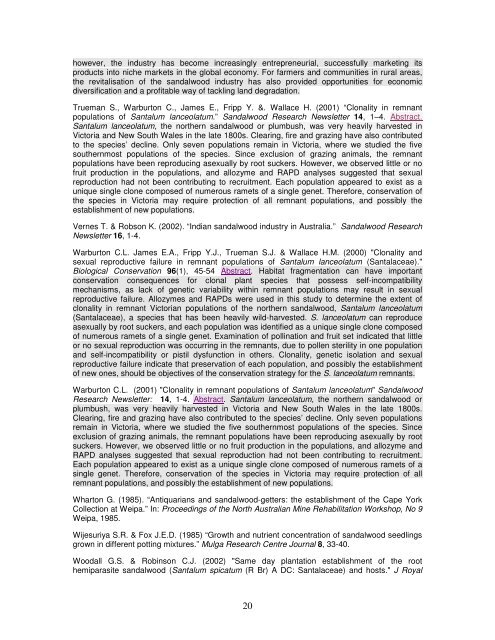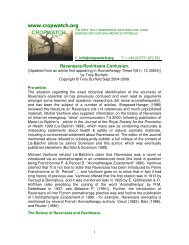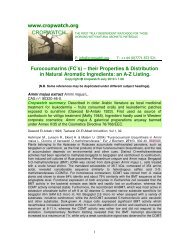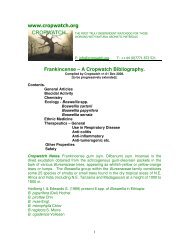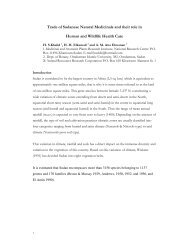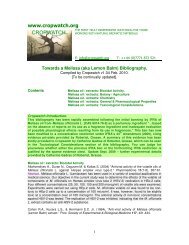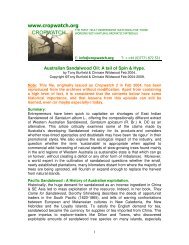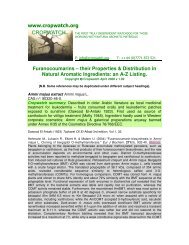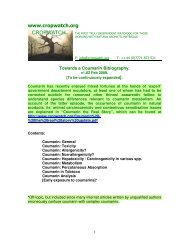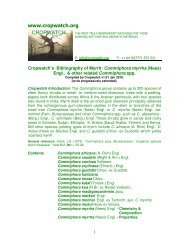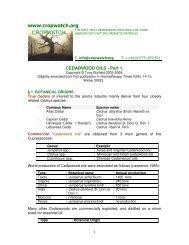Sandalwood Biblio - Cropwatch
Sandalwood Biblio - Cropwatch
Sandalwood Biblio - Cropwatch
You also want an ePaper? Increase the reach of your titles
YUMPU automatically turns print PDFs into web optimized ePapers that Google loves.
however, the industry has become increasingly entrepreneurial, successfully marketing its<br />
products into niche markets in the global economy. For farmers and communities in rural areas,<br />
the revitalisation of the sandalwood industry has also provided opportunities for economic<br />
diversification and a profitable way of tackling land degradation.<br />
Trueman S., Warburton C., James E., Fripp Y. &. Wallace H. (2001) “Clonality in remnant<br />
populations of Santalum lanceolatum.” <strong>Sandalwood</strong> Research Newsletter 14, 1–4. Abstract.<br />
Santalum lanceolatum, the northern sandalwood or plumbush, was very heavily harvested in<br />
Victoria and New South Wales in the late 1800s. Clearing, fire and grazing have also contributed<br />
to the species’ decline. Only seven populations remain in Victoria, where we studied the five<br />
southernmost populations of the species. Since exclusion of grazing animals, the remnant<br />
populations have been reproducing asexually by root suckers. However, we observed little or no<br />
fruit production in the populations, and allozyme and RAPD analyses suggested that sexual<br />
reproduction had not been contributing to recruitment. Each population appeared to exist as a<br />
unique single clone composed of numerous ramets of a single genet. Therefore, conservation of<br />
the species in Victoria may require protection of all remnant populations, and possibly the<br />
establishment of new populations.<br />
Vernes T. & Robson K. (2002). “Indian sandalwood industry in Australia.” <strong>Sandalwood</strong> Research<br />
Newsletter 16, 1-4.<br />
Warburton C.L. James E.A., Fripp Y.J., Trueman S.J. & Wallace H.M. (2000) "Clonality and<br />
sexual reproductive failure in remnant populations of Santalum lanceolatum (Santalaceae)."<br />
Biological Conservation 96(1), 45-54 Abstract. Habitat fragmentation can have important<br />
conservation consequences for clonal plant species that possess self-incompatibility<br />
mechanisms, as lack of genetic variability within remnant populations may result in sexual<br />
reproductive failure. Allozymes and RAPDs were used in this study to determine the extent of<br />
clonality in remnant Victorian populations of the northern sandalwood, Santalum lanceolatum<br />
(Santalaceae), a species that has been heavily wild-harvested. S. lanceolatum can reproduce<br />
asexually by root suckers, and each population was identified as a unique single clone composed<br />
of numerous ramets of a single genet. Examination of pollination and fruit set indicated that little<br />
or no sexual reproduction was occurring in the remnants, due to pollen sterility in one population<br />
and self-incompatibility or pistil dysfunction in others. Clonality, genetic isolation and sexual<br />
reproductive failure indicate that preservation of each population, and possibly the establishment<br />
of new ones, should be objectives of the conservation strategy for the S. lanceolatum remnants.<br />
Warburton C.L. (2001) "Clonality in remnant populations of Santalum lanceolatum" <strong>Sandalwood</strong><br />
Research Newsletter: 14, 1-4. Abstract. Santalum lanceolatum, the northern sandalwood or<br />
plumbush, was very heavily harvested in Victoria and New South Wales in the late 1800s.<br />
Clearing, fire and grazing have also contributed to the species’ decline. Only seven populations<br />
remain in Victoria, where we studied the five southernmost populations of the species. Since<br />
exclusion of grazing animals, the remnant populations have been reproducing asexually by root<br />
suckers. However, we observed little or no fruit production in the populations, and allozyme and<br />
RAPD analyses suggested that sexual reproduction had not been contributing to recruitment.<br />
Each population appeared to exist as a unique single clone composed of numerous ramets of a<br />
single genet. Therefore, conservation of the species in Victoria may require protection of all<br />
remnant populations, and possibly the establishment of new populations.<br />
Wharton G. (1985). “Antiquarians and sandalwood-getters: the establishment of the Cape York<br />
Collection at Weipa.” In: Proceedings of the North Australian Mine Rehabilitation Workshop, No 9<br />
Weipa, 1985.<br />
Wijesuriya S.R. & Fox J.E.D. (1985) “Growth and nutrient concentration of sandalwood seedlings<br />
grown in different potting mixtures.” Mulga Research Centre Journal 8, 33-40.<br />
Woodall G.S. & Robinson C.J. (2002) "Same day plantation establishment of the root<br />
hemiparasite sandalwood (Santalum spicatum (R Br) A DC: Santalaceae) and hosts." J Royal<br />
20


